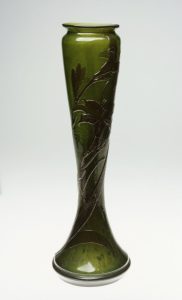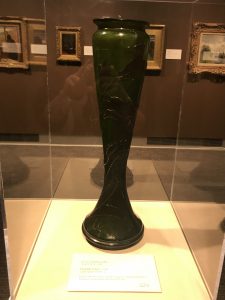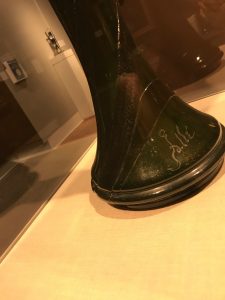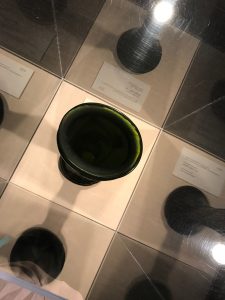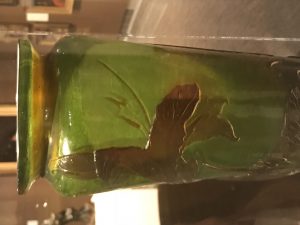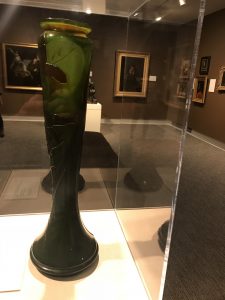The makers of the Daylily Vase were thoughtful about the general shape of a daylily – trumpet-like and dramatic – while deciding on the vase’s final proportions. Tall in stature and slimming in demeanor, the vase’s shape mimics the form of the decorative flowers that grace the surface of the green vase. A stretched hourglass, Daylily Vase’s top and bottom seem interchangeable much like Anish Kapoor’s 2002 large-scale installation Marsyas. Although the base is slightly larger than the opening and lip, it almost seems like one could turn the vase on its head and not notice. The fluid nature of the overall form – from the bottom: a slow thinning, stretching, and curved widening – represents the beautiful natural world Emile Gallé aimed to emulate through this vessel. In fact, every part of Emile Gallé’s Daylily Vase from the color to the contrasting transparent and opaque forms represents the natural world. Additionally, beyond the surface of the object, the process of making and manipulating glass metaphorically represents natural processes: molding, turning, pulling, and pinching the earth. Much like the surface and shape of the object, the making processes mimics natural processes.
The vase appears as though it was made in two stages. The stark difference between the precisely defined copper-colored flowers and the flowing transparency of the moss-colored body denotes a two-stage process; the copper-colored lilies seem effortlessly pasted on top of the green body. This hypothesis, however, was immediately refuted upon reading the label to the object: “Wheel Cut, Cameo Glass.” Cameo glass, a process of carving away fused layers of different-colored glass, was originally developed in ancient Rome. Using a similar process in the late nineteenth century, Emile Gallé’s team of glass craftsmen superimposed a copper-toned layer of glass onto a moss-green layer of glass. Once formed into a molten ball, the blowers were able to form the shape of the glass vase. The base was probably the biggest blow. Blowing, pulling, and then pinching to create the concave stem, the blowers would then create the top half of the vase. Finally, after shaping, pinching, pulling, and rolling to the desired shape, the glass would be squeezed with pliers once last time to create a small lip and opening. An active process that mimics the earth’s tectonic movements, the process of making the vase is volcanic. From molten glass to cooling crystallized sheets, the vase embodies natural processes while simultaneously exhibiting human control.
The overall shape of the object hints at its use: to hold daylilies. The elongated body would easily hold the tall stems of lilies, the shortening towards the bottom would hold them in place and keep their arrangement, and the conical area created by the widened base would hold water for the roots. Unlike the volcanic construction, the uptake and exchange of water is enabled through the artists’ choice to mimic the form of the flower. The decorative mimicking, too, signals properties of the flower beyond mere shape. After the glass vase was blown, the vase would either go into an acid-wash bath or be directly engraved and etched. Indeed, the daylily vase was likely copper-brown immediately after being blown; the green layer was invisible. The designer used a sharp wheel spinning incredibly fast to slowly cut away chunks of glass to reveal the moss green layer. To obtain the decorative flowers, the designer would literally cut around the flower forms, leaving them attached to the bottom layer of green glass. Unlike enameling, in which decoration is applied to the surface, the decoration of cameo glass is a sculptural process. As one can see in engaging close analysis of one of the flowers, the designer thought of the layer of copper glass as multiple layers of glass to create layering and depth. Some of the flowers’ petals, as seen below, seem in greater relief than others. By cutting more or less of the copper-colored layer of glass away, the designer was able to create flowers, petals, and stems with naturalistic depth. A metamorphosis, the natural world blooms through the process of cutting away.
Given that the lighting in the Ackland is both dim and artificial, the transparency of the vase is limited. One can readily imagine, however, that the transparency of the moss-green glass body would create a dazzling effect when placed in natural sunlight. Early naturalists and glassmakers constructed accurate scientific models that represented the translucent and permeable surfaces of nature, such as those who made the Blaschka flowers. Glass has the striking ability to reveal what is beneath the surface. Like flowers, whose pigments and cells can often be seen, the Daylily Vase shows small different-toned pigments in the green layer of moss. Ironically, the most mimetically natural part of the vase, the flowers themselves, hardly reveal any transparency beyond depth through layering. The most mimetically natural part of the vase, then, does not embody the structure and function of nature. Other elements, such as the transparency of the base and the shape, play the role of the lily. The vase thus embodies nature both through the natural properties of glass as well as the design and making process.
